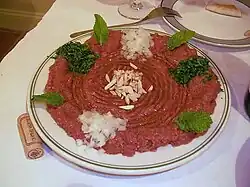 | |
| Course | Mezze |
|---|---|
| Region or state | Levant[1] |
| Main ingredients | Minced raw lamb or beef or Goat meat, bulgur, spices |
Kibbeh nayyeh or raw kibbeh (Arabic: كبة نيئة) is a Levantine[2][3][4] mezze popular in the Levant that likely originated in Aleppo.[5] It consists of minced raw lamb mixed with fine bulgur and spices.
Kibbeh nayyeh is often served with mint leaves, olive oil, and green onions. Pita bread is used to scoop it. It is sometimes served with a sauce of garlic or olive oil. The dish has a unique versatility in that any leftovers are cooked, creating a different dish.
Many recipes call for kibbe nayyeh as the "shell" for cooked kibbe, as well. In this case, however, the kibbe nayyeh is rolled into a ball and stuffed with lamb, onions, pine nuts and spices, then fried.
As in other dishes based on raw meat, health departments urge to exercise extreme caution when preparing and eating this kind of food.[6][7] Kibbeh nayyeh is a popular dish among Druze in Israel.[8] Kibbeh nayyeh is a popular dish among Christians in the Middle East on regular and holiday occasions such as Christmas and Easter.[9] It is also a popular dish among Palestinians of the Galilee.
History
There are different stories about the origins of Kibbeh nayyeh, however, it is believed that Aleppo is the most likely place where Kibbeh nayyeh evolved, Aleppines would slaughter animals on Sundays and feast days and eat the fresh meat raw.[10] Another story comes from the late 13th-century. In 1283 the Mamluk Sultanate invaded the Maronite region of Jebbet Bsharri (modern day Bsharri and Zgharta districts in North Lebanon) razing many villages and slaughtering or taking captive the inhabitants. When the Mamluks reached the village of Hadath El Jebbeh its inhabitants fled and took refuge in the 'Asi-al-Hadath grotto. The Mamluks then built a watchtower at the entrance of the grotto to monitor the Maronites. As a result of this many Maronites starved to death in the grotto. In order to survive, the Maronites started to eat raw meat, mixed with bulgur pounded in a stone mortar. Eating the meat raw allowed the Maronites to avoid revealing their location to the Mamluks, as cooking the meat would alert the Mamluks from the smoke of the fire. The siege ended after seven years when the Mamluks discovered the canal which fed water to the grotto by making their horses thirsty to discover the water source which they subsequently cut off from the grotto. This forced the Maronites to leave the grotto which led to the slaughtering of the men with the women being taken into captivity and the village of Hadath El Jebbeh being burnt to the ground. The tradition of kibbeh nayyeh was preserved and passed into present times as a reminder of the oppression and injustice that the Maronites went through.[11][12]
See also
- Kibbeh
- Çiğ köfte, a similar dish
- Kitfo, a similar dish
- List of beef dishes
- List of lamb dishes
- List of meat dishes
- Kafta, a similar dish
- Mett, similar German dish
References
- ↑ Marks, Gil (17 November 2010). Encyclopedia of Jewish Food. HMH. ISBN 978-0-544-18631-6 – via Google Books.
- ↑ Hage, Ghassan (2021). The Diasporic Condition: Ethnographic Explorations of the Lebanese in the World. The University of Chicago Press. p. 120. ISBN 9780226547060.
- ↑ Al-Khusaibi, Mohammed (2019), Al-Khusaibi, Mohammed; Al-Habsi, Nasser; Shafiur Rahman, Mohammad (eds.), "Arab Traditional Foods: Preparation, Processing and Nutrition", Traditional Foods: History, Preparation, Processing and Safety, Food Engineering Series, Cham: Springer International Publishing, pp. 9–35, doi:10.1007/978-3-030-24620-4_2, ISBN 978-3-030-24620-4, retrieved 2023-12-28
- ↑ Annia Ciezadlo (2012). Day of Honey: A Memoir of Food, Love, and War. Simon and Schuster. p. 349. ISBN 978-1-4391-5753-4.
- ↑ "LTHForum.com - Kibbe Nayeh (raw lamb tartare) كبة نية". www.lthforum.com. Retrieved 2023-12-28.
- ↑ Whipp, Ted (26 June 2012). "Raw meat dish banned by Windsor-Essex County Health Unit". Windsor Star. Retrieved 16 October 2022.
- ↑ Minicuci, Angela. "Salmonella Outbreak in Southeast Michigan Linked to Consumption of Raw Ground Beef". Michigan Department of Community Health. Retrieved 5 November 2014.
- ↑ Ashkenazi, Michael (2020). Food Cultures of Israel: Recipes, Customs, and Issues. ABC-CLIO. p. XXIII. ISBN 9781440866869.
- ↑ Edelstein, Sari (2010). Food, Cuisine, and Cultural Competency for Culinary, Hospitality, and Nutrition Professionals. Jones & Bartlett Publishers. p. 585. ISBN 9781449618117.
- ↑ "What is kibbeh nayyeh: The Lebanese dish of raw meat that we're finally ready for". amp.smh.com.au. Retrieved 2023-12-28.
- ↑ Douaihy, Estephan (1951). Tārīkh al Azminah. Beirut: al-Maṭbaʻah al-Kāthūlīkīyah. p. 146.
- ↑ "شو قصة "الكبّة النيّة"؟". alraiionline.com. جريدة الرأي. 4 February 2023.